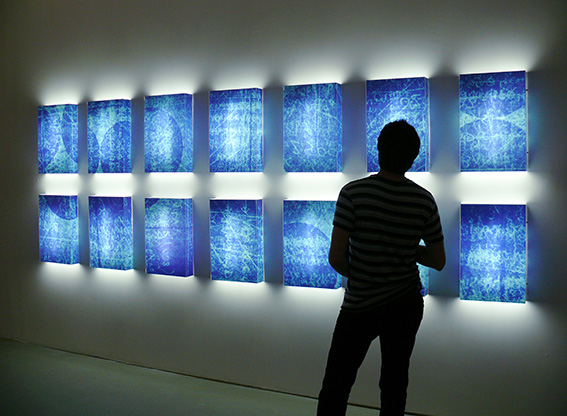
There is reciprocal tension between what is written about a visual artist’s work and the work itself: one is the unstable prop of the other, as in translation. But this tension is evidently more acute when the artist decides to work precisely with the signs of written forms, deconstructing them, bringing them back to an strange unfamiliarity.
This is the path that Marina Camargo has chosen to explore. All scholars are accustomed to see familiar linguistic signs as if they were the most natural thing in the universe, when they are conventional and arbitrary. Deconstructing the use of letters and words reminds one that this naturalness does not exist. Thus, Marina shows us fallen letters, letters undoing themselves from a text which breaks into pieces, or being picked up by her fingertips; inverted letters of city names on maps (and in this case what falls apart is the map, invisible); letters as palimpsests, superimposed and erased on a piece of carbon paper taken from the dustbin; illegible letters drawn half-unconsciously, like scribbles, on a sheet of paper… It isn’t about deconstructing just to deconstruct. One way or another, artists always re-signify their images, making them holders of new multiplied possible meanings, not always sought intentionally. There is no way to escape words. They even pop up in the artwork’s title. The choice of the name Carbon-14 for a series of images on carbon paper also evokes the chemical
marker used for biological dating, evoking the time accumulated by what we see. Playing with the polysemy and auto-reflexivity of images, or of words, was always an aspect characteristic of art, (artists, of course, have not only been conceptual as in today’s art, but also in the past when composing their works).
However, what we may call an intellectual process of elaborating images is mixed with another personally devoted one, in which words once again get lost; they can’t fathom the whole process of passage through the choice of techniques, materials, forms, colors, luminosity and also the insistence on some themes – a taste for maps, for example, which allude to routes, real or imagined, through cities. Words don’t account for the organization itself that guides a detailed task (translated, for example, into the placement of folders in a filing cabinet). All of this is placed, we could say, in the space between the lines of her artwork which aims to reveal the path it has taken in arriving.
This is what Marina does in this exhibition called Palavra Perdida (Lost Word). Born in the capital of Alagoas, Maceió, where she spent her childhood, today she lives in the state capital of Rio Grande do Sul, Porto Alegre. Having traveled to many cities around the world, she seeks, in the routes she takes through scribbling, letters, pages of books, filing cabinets, maps and cities, to traverse her path in a way that is more and more conscious and careful. And if she chose to explore this aspect – her relationship to writing – which has never ceased to be a central issue of the visual arts – it is to value and go deeply into investigating the specificity of the graphic and the image.
Text was written for the solo exhibition Palavra Perdida (Lost Word), in Galeria Virgilio (São Paulo, Brasil), in October 2008.
(English version: Alice Monsel)
